U.S. Inflation Cools to 3% in September, Fueling Expectations of a Fed Rate Cut
U.S. Inflation Cools to 3% in September, Fueling Expectations of a Fed Rate Cut
By
David Goldfarb
Last updated:
October 26, 2025
First Published:
October 26, 2025

Photo: Fortune
Inflation Slows More Than Forecast
Inflation in the United States cooled in September, coming in lower than economists anticipated and reinforcing hopes that the Federal Reserve could move ahead with another interest rate cut. The Consumer Price Index (CPI) rose 0.3% month-over-month and 3% year-over-year, according to data from the Bureau of Labor Statistics (BLS). Analysts had expected increases of 0.4% and 3.1%, respectively.
Core inflation — which excludes volatile food and energy prices — climbed 0.2% for the month and 3% annually, marking one of the slowest gains in nearly three years. That’s a notable moderation from the 0.3% monthly rises recorded in both July and August.
The data offers rare insight into the economy during the ongoing government shutdown, as most federal agencies have suspended reports. The BLS released the CPI specifically because it is used by the Social Security Administration to calculate annual cost-of-living adjustments (COLAs) for benefit recipients.
What’s Driving the Numbers
While overall inflation moderated, certain categories still showed noticeable movement. Gasoline prices spiked 4.1% in September, becoming the largest contributor to the monthly CPI increase. Food prices rose a modest 0.2%, and commodity prices climbed 0.5% overall.
Year-over-year, energy prices were up 2.8%, and food prices advanced 3.1%. Within the food index:
- Meat, poultry, fish, and eggs surged 5.2%
- Nonalcoholic beverages jumped 5.3%
- Electricity costs rose 5.1%
- Natural gas soared 11.7%, while gasoline prices actually fell 0.5% over the past year
Shelter — which makes up about one-third of the entire CPI weighting — saw a 0.2% increase for the month and 3.6% from a year ago, the smallest rise in over a year. Services excluding housing rose 0.2%, signaling modest but persistent cost pressures.
New vehicle prices rose 0.8%, while used cars and trucks fell 0.4%, continuing their downward trend as supply chain disruptions ease.
Market Reaction
The softer inflation reading was welcomed by Wall Street. Stock futures gained further momentum after the report, while Treasury yields edged slightly lower as traders priced in a near-certain rate cut at the Federal Open Market Committee (FOMC) meeting next week.
“This report gives investors the confirmation they were waiting for — inflation is cooling without collapsing demand,” one strategist said. “It keeps the Fed firmly on track to cut rates.”
Analysts now estimate a 100% probability that the Fed will lower its benchmark rate by 0.25 percentage points, from the current 4%–4.25% range, with another potential cut on the table for December.
Broader Economic Context
September’s CPI report is the last major data release before the Fed’s next policy decision. With inflation holding near 3% — still above the 2% target — policymakers face a delicate balancing act: sustaining progress against inflation while supporting an economy that has shown signs of slowing hiring and weaker business spending.
The slowdown in price growth also comes as the impact of Trump-era tariffs continues to ripple through supply chains. So far, the effects appear muted. Tariff-sensitive goods such as apparel rose 0.7%, while durable goods increased 0.3%. Economists note that many U.S. firms have already shifted sourcing to lower-tariff countries, softening the impact on consumer prices.
According to several market economists, the “realized tariff rate” — the effective rate after accounting for exemptions and import substitutions — remains around 10%, indicating that the U.S. economy has absorbed much of the shock more smoothly than expected.
Inflation Outlook and the Fed’s Next Move
While inflation has cooled, concerns remain that another spike in energy prices or supply disruptions could reignite upward pressure. At the same time, job growth has slowed in recent months, leading Fed officials to stress their dual mandate: maintaining price stability while ensuring full employment.
Fed Chair Jerome Powell and his colleagues have adopted a cautious tone, signaling they will continue cutting rates gradually. President Trump, however, has publicly urged more aggressive action, claiming “inflation is no longer a problem.”
Still, the September CPI reinforces a clear message — price pressures are easing faster than anticipated, and the economy appears to be moving toward a more stable equilibrium.
With inflation holding at 3% and underlying pressures moderating, the latest CPI report delivers a rare note of optimism amid fiscal uncertainty. Consumers are finally getting a breather after two years of persistent price hikes, and markets are betting heavily on the Fed easing policy in the coming weeks.
Whether this trend continues will depend on how energy prices, wage growth, and global supply conditions evolve heading into the final quarter of 2025. For now, however, the data suggests that the U.S. economy may be on the path toward a “soft landing” — lower inflation without a full-blown recession.
Popular articles
Subscribe to unlock premium content
Why Urban Beekeeping Is Becoming a Multi-Million-Dollar Eco Trend

How Allbirds Turned Wool Sneakers Into a Global Sustainability Trend

The Economics of Renting Hypercars to Tourists in Monaco

Why Urban Beekeeping Is Becoming a Multi-Million-Dollar Eco Trend

How Allbirds Turned Wool Sneakers Into a Global Sustainability Trend

Why Urban Beekeeping Is Becoming a Multi-Million-Dollar Eco Trend









